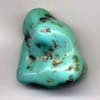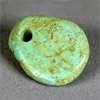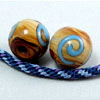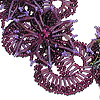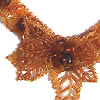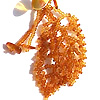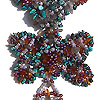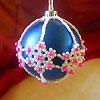December, 2007

Happy holidays!The holiday season is for family gatherings, fattening goodies, and flickering lights. Enjoy the season because before you know it, the year will be through. We love and appreciate you! In the final issue of 2007 year:
Turquoise - December birthstone
Sale on MyLovelyBeads.com! Featured artist - Susan Daigle Our 2007 Awards Christmas baubles Jewelry care tips January upcoming events Again, happy holidays!
MyLovelyBeads.com Team |
Turquoise - December birthstone
|
|
Holiday Season Sale on MyLovelyBeads.com!
December is a busy time for all of us
making gifts for the loved ones that are going under
a Christmas tree! Time is running out! Be sure to get in
your final holiday orders! Hurry up, MyLovelyBeads.com
offers you Holiday Season Sale:
• 10% off for all orders placed before January, 10
• 10% off for all custom orders placed before January, 10 • Free shipping for all orders of $200 and more |
|
Featured artistWHAT IS KUMIHIMO AND SHOULD I BE WORRIED? Her name is Susan Daigle. She is from the beautiful state of Maine, up in the northeastern part of the United States, where summers are warm and green and the winters are cold and colder. She discovered her love of jewelry almost three years ago when she picked up her first beading magazine, she thinks it was Beadstyle. Then she found a wonderful bead shop, Beads on the Kennebec, just 20 miles away, in Augusta, the beautiful capitol of the state of Main. Almost next door! And when she walked through that door she knew that creating jewelry was for her... Full Susan's story about braided jewelry... |
|
Our 2007 Awards
Rings & Things "Your Designs Rock!" 2007 Jewelry Design Contest.
• Aquamarine Morning and Amethyst Night Necklace. Glass Category.
First Place
Fire Mountain Gems and Beads 2006-2007 Beading Contest.
|
|
Christmas baubles
Jingle Bells, Jingle Bells,
Today is all about the holiday season! Including the art of beading. Beadwork
artist Elena Solov'eva lives in Moscow, Russia. She is a mathematician and works
for the Russian Academy of Sciences. Elena was always fond of crafts. She applied
her first beadwork skills a few years ago helping her daughter figure out bead
patterns. After her daughter stopped beading, Elena enjoyed the process of
designing, creating jewelry, and beaded sculptures so much that she continued to
create custom beadwork. One of her favorite items are the
Christmas baubles, working on them always keeps her in good mood. We hope,
that looking at the gallery of Elena Solov'eva's beadwork will do the same with
you! If you like Elena's art of beading, you can contact her at
solel@yandex.ru, or just visit her own
beadwork gallery.
Jingle all the way! What fun it is to ride In a one-horse open sleigh!
|
|
Jewelry care tips• Be careful not to spoil jewelry on clothing. Put jewelry on after dressing, and remove it first. • Keep a sterling silver polishing cloth handy for a quick wipe before wearing. These can be purchased in a most jewelry & discount stores. • Do not wear your jewelry into a swimming pool or use around chemicals. Humidity, cleaning supplies, and pool/spa water can quickly oxidize or discolor your jewelry, especially sterling silver. • Avoid contact with chemicals, such as perfume, hair spray, deodorant, household cleaning fluids, and etc. Do not use abrasive jewelry cleaners. • Store jewelry made from silver and other metals prone to tarnishing in an tight air-tight or zip-lock plastic bags. This high tech method of storing your things will keep them looking like new for a long time. Do not store pearl jewelry in sealed bags! • Most jewelry can be cleaned with a soft cloth and mild detergent with water if required, rinse with clear water and dry with a soft cloth. Test an inconspicuous area for color fastness before cleaning the whole piece. • If you use a jewelry cleaning liquid, read the instructions carefully before using. Some types of beads and gems, including pearls, turquoise, opal, and other soft stones, should never be put into any cleaning solution. • Remove jewelry before going to bed. Sleeping in your jewelry can add extra stress to chains, joints, etc., and shorten the life of your things! |
|
Upcoming events
January 25, 26, 27, 2008 Juried Fine Art & Craft Festivals since 1976. Find the unique handcrafted artwork of thousands of American Artists! Decorative creations for home & garden, exceptional fine art & designer crafts! |
© 2010 MyLovelyBeads.com All Rights Reserved.
If you do not want receive our newsletter and you wish to remove your email address from our mailing list, please click the following link to unsubscribe.



